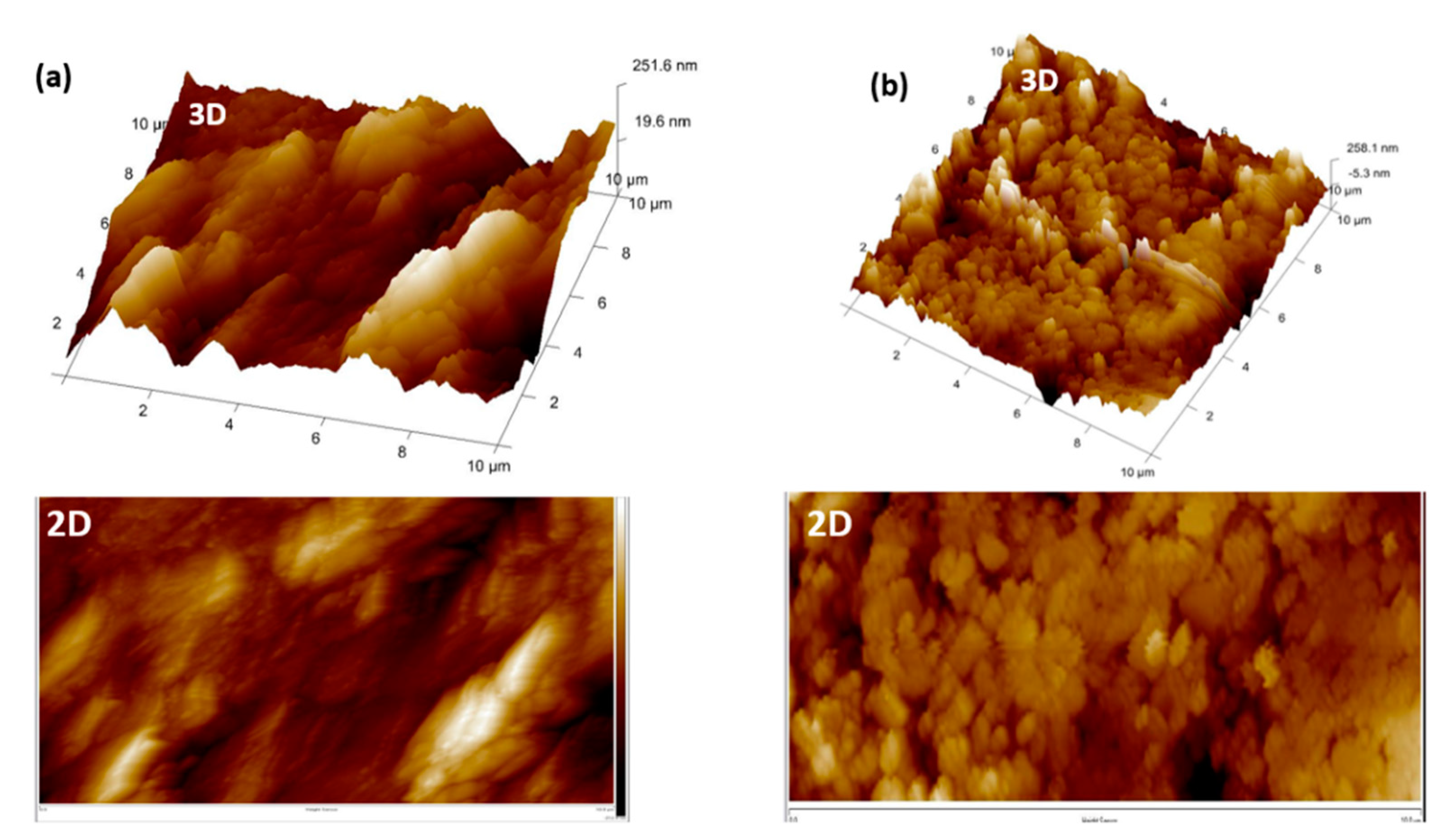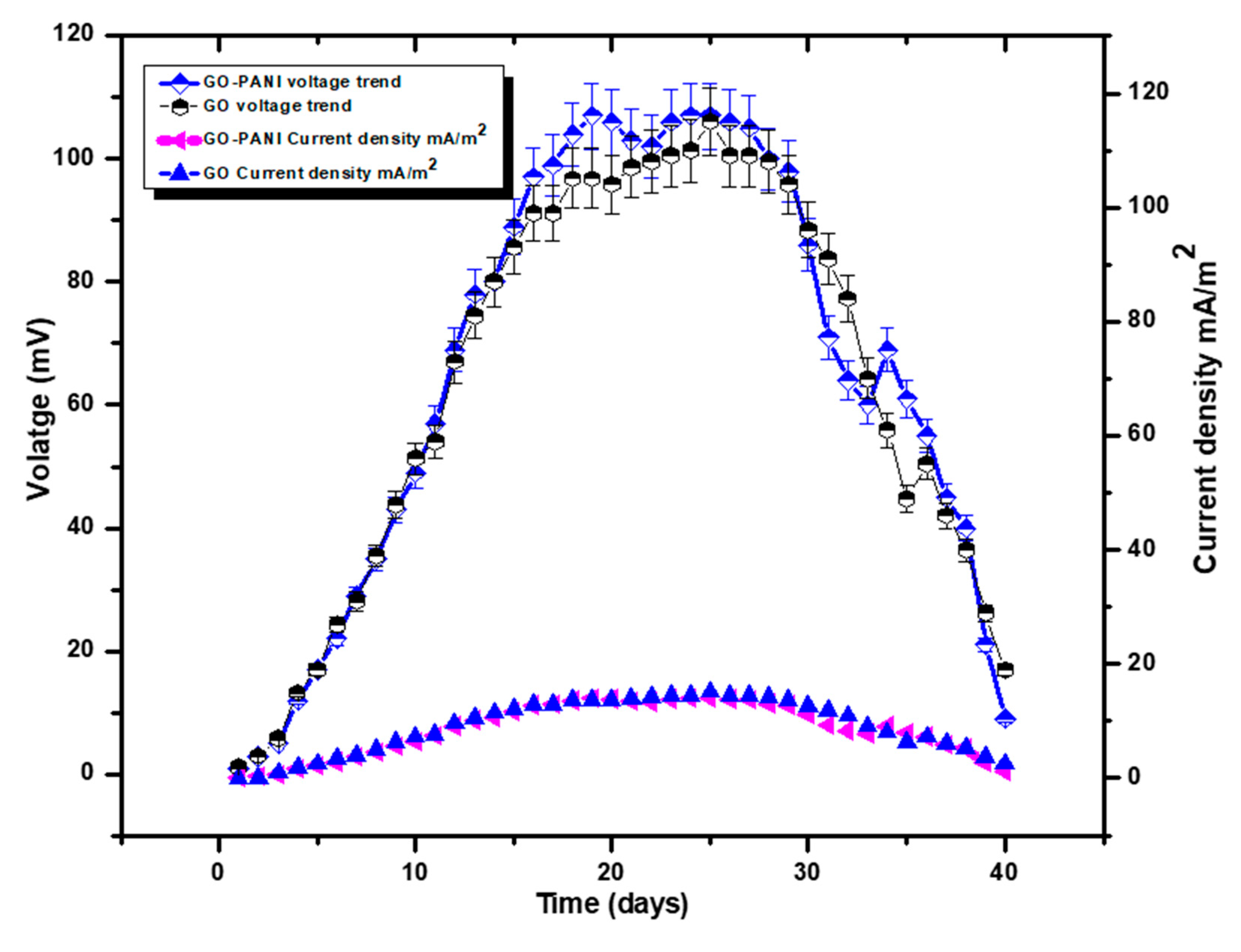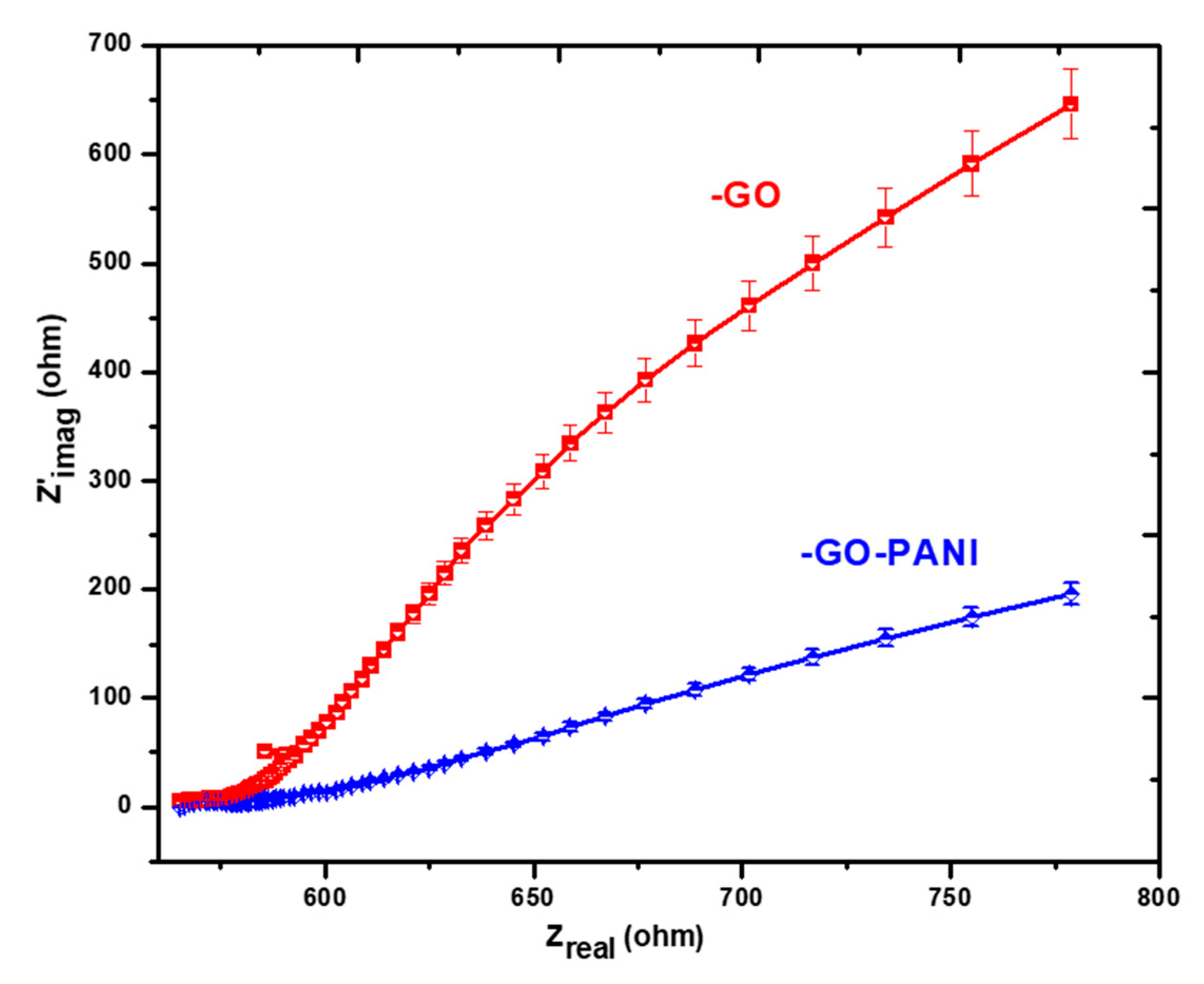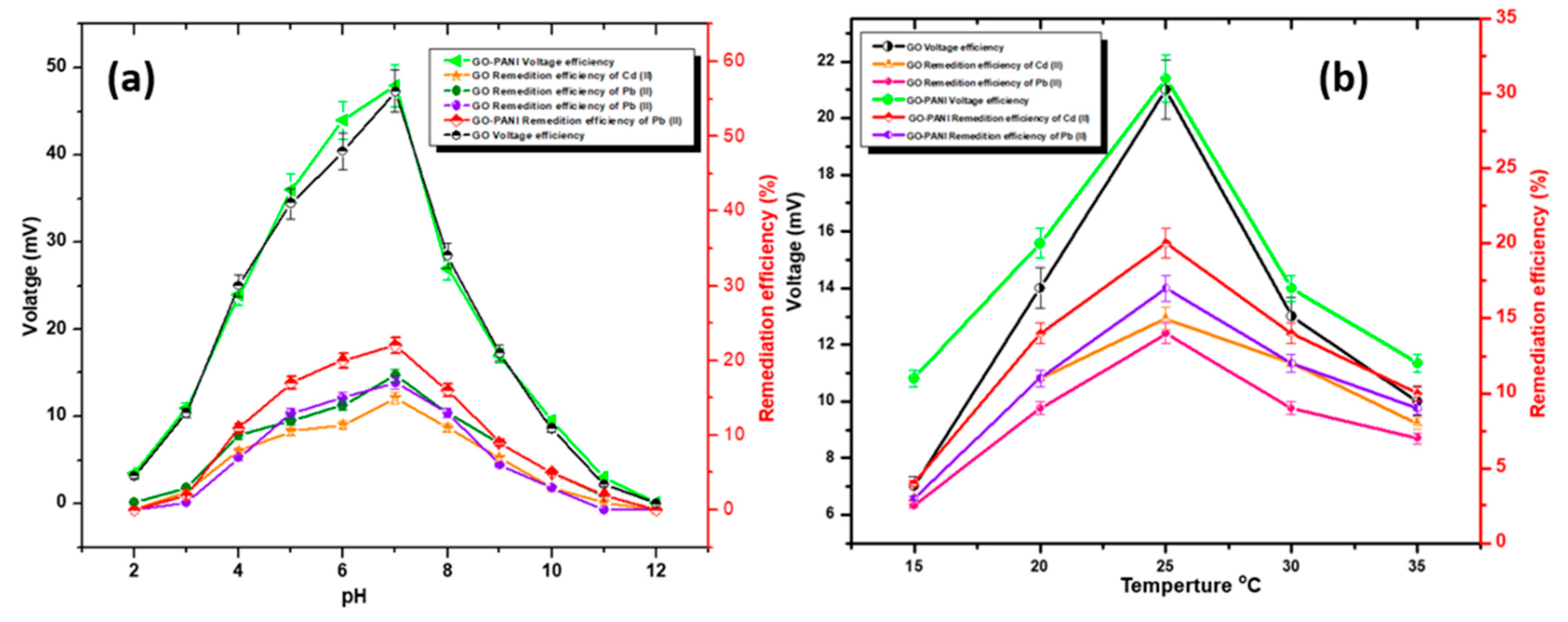Cellulose Derived Graphene/Polyaniline Nanocomposite Anode for Energy Generation and Bioremediation of Toxic Metals via Benthic Microbial Fuel Cells
Abstract
:1. Introduction
2. Experimental Details
2.1. Chemical and Materials
2.2. Preparation of GO
2.3. Preparation of GO-PANI Nanocomposite
2.4. Prepared Material Characterization
2.5. Fabrication of Anode
2.6. BMFCs Inoculation Source, Setup, and Operational Parameters
2.6.1. Inoculation Source Preparation
2.6.2. BMFCs Setup and Operation Parameters
2.7. Electrochemical Measurements
2.8. Remediation Performance and Biofilm Morphology of Prepared Anodes
2.9. Parameter Optimization
3. Result and Discussion
3.1. Material Characterizations
3.1.1. FT-IR Analysis
3.1.2. TGA Analysis
3.1.3. UV-Absorbance Analysis
3.1.4. XRD Analysis
3.1.5. SEM and TEM Analysis
3.1.6. AFM Analysis
3.2. Self-Fabricated Electrode Performance in BMFCs
3.2.1. Voltage Generation Trend and Polarization Behavior
3.2.2. Electrochemical Measurements
3.2.3. Remediation Performance of Metal Ions via BMFCs by Using Fabricated Anode
3.2.4. Studies of Electrode Biofilm and Bacterial Species Analysis
3.3. Multiple Parameter Optimization
3.3.1. Effect of pH on Energy Generation and Remediation Efficiency of Cd (II) and Pb (II)
3.3.2. Effect of Temperature on Energy Generation and Remediation Efficiency of Cd (II) and Pb (II)
3.3.3. Effect of Organic Substrate on Energy Generation and Remediation Efficiency of Cd (II) and Pb (II)
4. Conclusions and Future Perspectives
Author Contributions
Funding
Institutional Review Board Statement
Informed Consent Statement
Data Availability Statement
Conflicts of Interest
References
- Zhang, L.; Wang, J.; Fu, G.; Zhang, Z. Simultaneous electricity generation and nitrogen and carbon removal in single-chamber microbial fuel cell for high-salinity wastewater treatment. J. Clean. Prod. 2020, 276, 123203. [Google Scholar] [CrossRef]
- Logan, B.E.; Hamelers, B.; Rozendal, R.; Schröder, U.; Keller, J.; Freguia, S.; Aelterman, P.; Verstraete, W.; Rabaey, K. Microbial fuel cells: Methodology and technology. Environ. Sci. Technol. 2006, 40, 5181–5192. [Google Scholar] [CrossRef] [PubMed]
- Logan, B.E.; Rabaey, K. Conversion of wastes into bioelectricity and chemicals by using microbial electrochemical technologies. Science 2012, 337, 686–690. [Google Scholar] [CrossRef] [PubMed] [Green Version]
- Logan, B.E. Exoelectrogenic bacteria that power microbial fuel cells. Nat. Rev. Microbiol. 2009, 7, 375–381. [Google Scholar] [CrossRef] [PubMed]
- Yaqoob, A.A.; Khatoon, A.; Mohd Setapar, S.H.; Umar, K.; Parveen, T.; Mohamad Ibrahim, M.N.; Ahmad, A.; Rafatullah, M. Outlook on the role of microbial fuel cells in remediation of environmental pollutants with electricity generation. Catalysts 2020, 10, 819. [Google Scholar] [CrossRef]
- Rabaey, K.; Verstraete, W. Microbial fuel cells: Novel biotechnology for energy generation. Trends Biotechnol. 2005, 23, 291–298. [Google Scholar] [CrossRef]
- Nielsen, M.E.; Wu, D.M.; Girguis, P.R.; Reimers, C.E. Influence of substrate on electron transfer mechanisms in chambered benthic microbial fuel cells. Environ. Sci. Technol. 2009, 43, 8671–8677. [Google Scholar] [CrossRef]
- Yaqoob, A.A.; Ibrahim, M.N.M.; Yaakop, A.S.; Umar, K.; Ahmad, A. Modified Graphene Oxide Anode: A Bioinspired Waste Material for Bioremediation of Pb2+ with Energy Generation through Microbial Fuel Cells. Chem. Eng. J. 2020, 128052. [Google Scholar] [CrossRef]
- Tang, C.; Zhao, Y.; Kang, C.; Yang, Y.; Morgan, D.; Xu, L. Towards concurrent pollutants removal and high energy harvesting in a pilot-scale CW-MFC: Insight into the cathode conditions and electrodes connection. Chem. Eng. J. 2019, 373, 150–160. [Google Scholar] [CrossRef]
- Tavakolian, M.; Taleghani, H.G.; Khorshidian, M. New design of benthic microbial fuel cell for bioelectricity generation: Comparative study. Int. J. Hydrogen Energy 2020, 45, 23533–23542. [Google Scholar] [CrossRef]
- Oliveira, V.B.; Simões, M.; Melo, L.F.; Pinto, A.M. Overview on the developments of microbial fuel cells. Biochem. Eng. J. 2013, 7, 53–64. [Google Scholar] [CrossRef]
- Pushkar, P.; Prakash, O.; Mungray, A.; Kumar, K.; Chongdar, S.; Mungray, A. Evaluation of the effect of position and configuration of electrodes in benthic microbial fuel cell. Fuel Cells 2018, 18, 509–517. [Google Scholar] [CrossRef]
- Yaqoob, A.A.; Ibrahim, M.N.M.; Ahmad, A.; Reddy, A.V.B. Toxicology and Environmental Application of Carbon Nanocomposite. In Environmental Remediation through Carbon Based Nano Composites; Springer: Berlin/Heidelberg, Germany, 2021; pp. 1–18. [Google Scholar]
- Zhao, F.; Slade, R.C.; Varcoe, J.R. Techniques for the study and development of microbial fuel cells: An electrochemical perspective. Chem. Soc. Rev. 2009, 38, 1926–1939. [Google Scholar] [CrossRef] [PubMed] [Green Version]
- Yaqoob, A.A.; Mohamad Ibrahim, M.N.; Rafatullah, M.; Chua, Y.S.; Ahmad, A.; Umar, K. Recent Advances in Anodes for Microbial Fuel Cells: An Overview. Materials 2020, 13, 2078. [Google Scholar] [CrossRef]
- Yaqoob, A.A.; Ibrahim, M.N.M.; Rodríguez-Couto, S. Development and modification of materials to build cost-effective anodes for microbial fuel cells (MFCs): An overview. Biochem. Eng. J. 2020, 164, 107779. [Google Scholar] [CrossRef]
- Kirubaharan, C.J.; Yoo, D.J.; Kim, A.R. Graphene/poly (3, 4-ethylenedioxythiophene)/Fe3O4 nanocomposite–An efficient oxygen reduction catalyst for the continuous electricity production from wastewater treatment microbial fuel cells. Int. J. Hydrogen Energy 2016, 41, 13208–13219. [Google Scholar]
- Gnana kumar, G.; Kirubaharan, C.J.; Udhayakumar, S.; Karthikeyan, C.; Nahm, K.S. Conductive polymer/graphene supported platinum nanoparticles as anode catalysts for the extended power generation of microbial fuel cells. Ind. Eng. Chem. Res. 2014, 53, 16883–16893. [Google Scholar] [CrossRef]
- Thambidurai, S.; Pandiselvi, K. Polyaniline/natural polymer composites and nanocomposites. In Polyaniline Blends, Composites, and Nanocomposites; Elsevier: Amsterdam, The Netherlands, 2018; pp. 235–256. [Google Scholar]
- Yong, Y.-C.; Dong, X.-C.; Chan-Park, M.B.; Song, H.; Chen, P. Macroporous and monolithic anode based on polyaniline hybridized three-dimensional graphene for high-performance microbial fuel cells. ACS Nano 2012, 6, 2394–2400. [Google Scholar] [CrossRef]
- Zhao, C.; Gai, P.; Liu, C.; Wang, X.; Xu, H.; Zhang, J.; Zhu, J.-J. Polyaniline networks grown on graphene nanoribbons-coated carbon paper with a synergistic effect for high-performance microbial fuel cells. J. Mater. Chem. A 2013, 1, 12587–12594. [Google Scholar] [CrossRef]
- Sekeri, S.H.; Ibrahim, M.N.M.; Umar, K.; Yaqoob, A.A.; Azmi, M.N.; Hussin, M.H.; Othman, M.B.H.; Malik, M.F.I.A. Preparation and characterization of nanosized lignin from oil palm (Elaeis guineensis) biomass as a novel emulsifying agent. Int. J. Biol. Macromol. 2020, 164, 3114–3124. [Google Scholar] [CrossRef]
- Zaaba, N.; Foo, K.; Hashim, U.; Tan, S.; Liu, W.-W.; Voon, C. Synthesis of graphene oxide using modified hummers method: Solvent influence. Procedia Eng. 2017, 184, 469–477. [Google Scholar] [CrossRef]
- Shahriary, L.; Athawale, A.A. Graphene oxide synthesized by using modified hummers approach. Int. J. Renew. Energy Environ. Eng. 2014, 2, 58–63. [Google Scholar]
- Zheng, J.; Ma, X.; He, X.; Gao, M.; Li, G. Praparation, characterizations, and its potential applications of PANi/graphene oxide nanocomposite. Procedia Eng. 2012, 27, 1478–1487. [Google Scholar] [CrossRef] [Green Version]
- Ferdman, A. Insoluble Titanium-Lead Anode for Sulfate Electrolytes. U.S. Patent 6,129,822, 10 October 2000. [Google Scholar]
- Timmers, R.A.; Strik, D.P.; Hamelers, H.V.; Buisman, C.J. Characterization of the internal resistance of a plant microbial fuel cell. Electrochim. Acta 2012, 72, 165–171. [Google Scholar] [CrossRef]
- Igboamalu, T.E.; Bezuidenhout, N.; Matsena, M.T.; Chirwa, E. Microbial fuel cell power output and growth: Effect of pH on anaerobic microbe consortium. Chem. Eng. Trans. 2019, 76, 1381–1387. [Google Scholar]
- Xie, X.; Hu, L.; Pasta, M.; Wells, G.F.; Kong, D.; Criddle, C.S.; Cui, Y. Three-dimensional carbon nanotube− textile anode for high-performance microbial fuel cells. Nano Lett. 2011, 11, 291–296. [Google Scholar] [CrossRef] [PubMed]
- Chen, S.; He, G.; Carmona-Martinez, A.A.; Agarwal, S.; Greiner, A.; Hou, H.; Schröder, U. Electrospun carbon fiber mat with layered architecture for anode in microbial fuel cells. Electrochem. Commun. 2011, 13, 1026–1029. [Google Scholar] [CrossRef]
- Tang, J.; Liu, T.; Yuan, Y.; Zhuang, L. Effective control of bioelectricity generation from a microbial fuel cell by logical combinations of pH and temperature. Sci. World J. 2014, 2014. [Google Scholar] [CrossRef]
- Rajeswari, S.; Vidhya, S.; Krishnaraj, R.N.; Saravanan, P.; Sundarapandiyan, S.; Maruthamuthu, S.; Ponmariappan, S.; Vijayan, M. Utilization of soak liquor in microbial fuel cell. Fuel 2016, 181, 148–156. [Google Scholar] [CrossRef]
- Kim, J.; Park, S.-J.; Kim, S. Capacitance behaviors of polyaniline/graphene nanosheet composites prepared by aniline chemical polymerization. Carbon Lett. (Carbon Lett.) 2013, 14, 51–54. [Google Scholar] [CrossRef] [Green Version]
- Parveen, N.; Mahato, N.; Ansari, M.O.; Cho, M.H. Enhanced electrochemical behavior and hydrophobicity of crystalline polyaniline@ graphene nanocomposite synthesized at elevated temperature. Compos. Part B Eng. 2016, 87, 281–290. [Google Scholar] [CrossRef]
- Shao, W.; Jamal, R.; Xu, F.; Ubul, A.; Abdiryim, T. The effect of a small amount of water on the structure and electrochemical properties of solid-state synthesized polyaniline. Materials 2012, 5, 1811–1825. [Google Scholar] [CrossRef] [Green Version]
- Mohamadzadeh, M.M.H.; Sabury, S.; Gudarzi, M.M.; Sharif, F. Graphene oxide-induced polymerization and crystallization to produce highly conductive polyaniline/graphene oxide composite. J. Polym. Sci. Part A Polym. Chem. 2014, 52, 1545–1554. [Google Scholar] [CrossRef]
- Lin, Y.-C.; Hsu, F.-H.; Wu, T.-M. Enhanced conductivity and thermal stability of conductive polyaniline/graphene composite synthesized by in situ chemical oxidation polymerization with sodium dodecyl sulfate. Synth. Met. 2013, 184, 29–34. [Google Scholar] [CrossRef]
- Yan, J.; Wei, T.; Shao, B.; Fan, Z.; Qian, W.; Zhang, M.; Wei, F. Preparation of a graphene nanosheet/polyaniline composite with high specific capacitance. Carbon 2010, 48, 487–493. [Google Scholar] [CrossRef]
- Yaqoob, A.A.; Khan, R.M.; Saddique, A. Review article on applications and classification of gold nanoparticles. Int. J. Res. 2019, 6, 762–768. [Google Scholar]
- Yaqoob, A.A.; Ibrahim, M.N.M. A Review Article of Nanoparticles; Synthetic Approaches and Wastewater Treatment Methods. Int. Res. J. Eng. Technol. 2019, 6, 1–7. [Google Scholar]
- Baragaño, D.; Forján, R.; Welte, L.; Gallego, J.L.R. Nanoremediation of As and metals polluted soils by means of graphene oxide nanoparticles. Sci. Rep. 2020, 10, 1896. [Google Scholar] [CrossRef]
- Amirabad, R.; Saadatabadi, A.R.; Siadati, M.H. Preparation of polyaniline/graphene coated wearable thermoelectric fabric using ultrasonic-assisted dip-coating method. Mater. Renew. Sustain. Energy 2020, 9, 21. [Google Scholar] [CrossRef]
- Yaqoob, A.A.; Serrà, A.; Ibrahim, M.N.M. Advances and Challenges in Developing Efficient Graphene Oxide-Based ZnO Photocatalysts for Dye Photo-Oxidation. Nanomaterials 2020, 10, 932. [Google Scholar] [CrossRef]
- Sajana, T.; Ghangrekar, M.; Mitra, A. Application of sediment microbial fuel cell for in situ reclamation of aquaculture pond water quality. Aquac. Eng. 2013, 57, 101–107. [Google Scholar] [CrossRef]
- Sajana, T.; Ghangrekar, M.; Mitra, A. Effect of presence of cellulose in the freshwater sediment on the performance of sediment microbial fuel cell. Bioresour. Technol. 2014, 155, 84–90. [Google Scholar] [CrossRef] [PubMed]
- Prakash, O.; Pushkar, P.; Mungray, A.K.; Mungray, A.; Kailasa, S.K. Effect of geometrical position of a multi-anode system in power output and nutritional variation in benthic microbial fuel cells. J. Environ. Chem. Eng. 2018, 6, 1558–1568. [Google Scholar] [CrossRef]
- Karra, U.; Muto, E.; Umaz, R.; Kölln, M.; Santoro, C.; Wang, L.; Li, B. Performance evaluation of activated carbon-based electrodes with novel power management system for long-term benthic microbial fuel cells. Int. J. Hydrogen Energy 2014, 39, 21847–21856. [Google Scholar] [CrossRef]
- Schrader, P.S.; Reimers, C.E.; Girguis, P.; Delaney, J.; Doolan, C.; Wolf, M.; Green, D. Independent benthic microbial fuel cells powering sensors and acoustic communications with the MARS underwater observatory. J. Atmos. Ocean. Technol. 2016, 33, 607–617. [Google Scholar] [CrossRef]
- Liu, B.; Williams, I.; Li, Y.; Wang, L.; Bagtzoglou, A.; McCutcheon, J.; Li, B. Towards high power output of scaled-up benthic microbial fuel cells (BMFCs) using multiple electron collectors. Biosens. Bioelectron. 2016, 79, 435–441. [Google Scholar] [CrossRef] [Green Version]
- Martins, G.; Peixoto, L.; Ribeiro, D.C.; Parpot, P.; Brito, A.G.; Nogueira, R. Towards implementation of a benthic microbial fuel cell in lake Furnas (Azores): Phylogenetic affiliation and electrochemical activity of sediment bacteria. Bioelectrochemistry 2010, 78, 67–71. [Google Scholar] [CrossRef] [Green Version]
- Li, H.; Tian, Y.; Qu, Y.; Qiu, Y.; Liu, J.; Feng, Y. A pilot-scale benthic microbial electrochemical system (BMES) for enhanced organic removal in sediment restoration. Sci. Rep. 2017, 7, 39802. [Google Scholar] [CrossRef] [Green Version]
- Liu, L.; Chou, T.-Y.; Lee, C.-Y.; Lee, D.-J.; Su, A.; Lai, J.-Y. Performance of freshwater sediment microbial fuel cells: Consistency. Int. J. Hydrogen Energy 2016, 41, 4504–4508. [Google Scholar] [CrossRef]
- Xu, P.; Xiao, E.-R.; Xu, D.; Zhou, Y.; He, F.; Liu, B.-Y.; Zeng, L.; Wu, Z.-B. Internal nitrogen removal from sediments by the hybrid system of microbial fuel cells and submerged aquatic plants. PLoS ONE 2017, 12, e0172757. [Google Scholar] [CrossRef]
- Hung, Y.-H.; Liu, T.-Y.; Chen, H.-Y. Renewable coffee waste-derived porous carbons as anode materials for high-performance sustainable microbial fuel cells. ACS Sustain. Chem. Eng. 2019, 7, 16991–16999. [Google Scholar] [CrossRef]
- Yaqoob, A.A.; Ahmad, H.; Parveen, T.; Ahmad, A.; Oves, M.; Ismail, I.M.; Qari, H.A.; Umar, K.; Mohamad Ibrahim, M.N. Recent Advances in Metal Decorated Nanomaterials and Their Various Biological Applications: A Review. Front. Chem. 2020, 8, 341–363. [Google Scholar] [CrossRef] [PubMed]
- Vunain, E.; Mishra, A.; Mamba, B. Dendrimers, mesoporous silicas and chitosan-based nanosorbents for the removal of heavy-metal ions: A review. Int. J. Biol. Macromol. 2016, 86, 570–586. [Google Scholar] [CrossRef] [PubMed]
- Singh, S.; Songera, D.S. A review on microbial fuel cell using organic waste as feed. CIB Tech J. Biotechnol. 2012, 2, 17–27. [Google Scholar]
- Di Martino, P. Extracellular polymeric substances, a key element in understanding biofilm phenotype. AIMS Microbiol. 2018, 4, 274. [Google Scholar] [CrossRef]
- Kumar, M.A.; Anandapandian, K.T.K.; Parthiban, K. Production and characterization of exopolysaccharides (EPS) from biofilm forming marine bacterium. Braz. Arch. Biol. Technol. 2011, 54, 259–265. [Google Scholar] [CrossRef] [Green Version]
- Nimje, V.R.; Chen, C.Y.; Chen, C.C.; Jean, J.S.; Reddy, A.S.; Fan, C.W.; Pan, K.Y.; Liu, H.T.; Chen, J.L. Stable and high energy generation by a strain of Bacillus subtilis in a microbial fuel cell. J. Power Sources 2009, 190, 258–263. [Google Scholar] [CrossRef]
- Ayangbenro, A.S.; Babalola, O.O. Genomic analysis of Bacillus cereus NWUAB01 and its heavy metal removal from polluted soil. Sci. Rep. 2020, 10, 19660. [Google Scholar] [CrossRef]
- Fedorovich, V.; Knighton, M.C.; Pagaling, E.; Ward, F.B.; Free, A.; Goryanin, I. Novel electrochemically active bacterium phylogenetically related to Arcobacter butzleri, isolated from a microbial fuel cell. Appl. Environ. Microbiol. 2009, 75, 7326–7334. [Google Scholar] [CrossRef] [Green Version]
- Rabaey, K.; Read, S.T.; Clauwaert, P.; Freguia, S.; Bond, P.L.; Blackall, L.L.; Keller, J. Cathodic oxygen reduction catalyzed by bacteria in microbial fuel cells. ISME J. 2008, 2, 519–527. [Google Scholar] [CrossRef]
- Umar, K.; Yaqoob, A.A.; Ibrahim, M.N.M.; Parveen, T.; Safian, M.T. Environmental applications of smart polymer composites. Smart Polym. Nanocompos. Biomed. Environ. Appl. 2020, 15, 295–320. [Google Scholar]
- Nath, S.; Deb, B.; Sharma, I. Isolation and characterization of cadmium and lead resistant bacteria. Glob. Adv. Res. J. Microbiol. 2012, 1, 194–198. [Google Scholar]
- Yaqoob, A.A.; Parveen, T.; Umar, K.; Ibrahim, M.N.M. Role of nanomaterials in the treatment of wastewater: A review. Water 2020, 12, 495. [Google Scholar] [CrossRef] [Green Version]
- Rodríguez, C.E.; Quesada, A. Nickel biosorption by Acinetobacter baumannii and Pseudomonas aeruginosa isolated from industrial wastewater. Braz. J. Microbiol. 2006, 37, 465–467. [Google Scholar] [CrossRef]
- Sciarria, T.P.; Arioli, S.; Gargari, G.; Mora, D.; Adani, F. Monitoring microbial communities’ dynamics during the start-up of microbial fuel cells by high-throughput screening techniques. Biotechnol. Rep. 2019, 21, 310. [Google Scholar]
- Chuo, S.C.; Mohamed, S.F.; Mohd, S.S.H.; Ahmad, A.; Jawaid, M.; Wani, W.A.; Yaqoob, A.A.; Ibrahim, M.N.M. Insights into the Current Trends in the Utilization of Bacteria for Microbially Induced Calcium Carbonate Precipitation. Materials 2020, 13, 4993. [Google Scholar] [CrossRef]
- Mizan, M.F.; Jahid, I.K.; Park, S.Y.; Silva, J.L.; Kim, T.J.; Myoung, J.; Ha, S.D. Effects of temperature on biofilm formation and quorum sensing of Aeromonas hydrophila. Ital. J. Food Sci. 2018, 30, 456–466. [Google Scholar]
- Li, L.H.; Sun, Y.M.; Yuan, Z.H.; Kong, X.Y.; Li, Y. Effect of temperature change on power generation of microbial fuel cell. Environ. Technol. 2013, 34, 1929–1934. [Google Scholar] [CrossRef]
- Huang, L.; Chai, X.; Quan, X.; Logan, B.E.; Chen, G. Reductive dechlorination and mineralization of pentachlorophenol in biocathode microbial fuel cells. Bioresour. Technol. 2012, 111, 167–174. [Google Scholar] [CrossRef] [PubMed]
- Yuan, Y.; Zhao, B.; Zhou, S.; Zhong, S.; Zhuang, L. Electrocatalytic activity of anodic biofilm responses to pH changes in microbial fuel cells. Bioresour. Technol. 2011, 102, 6887–6891. [Google Scholar] [CrossRef]
- Din, M.I.; Iqbal, M.; Hussain, Z.; Khalid, R. Bioelectricity generation from waste potatoes using single chambered microbial fuel cell. Energy Sources Part A Recovery Util. Environ. Eff. 2020, 1–11. [Google Scholar] [CrossRef]
- Sharma, Y.; Li, B. The variation of power generation with organic substrates in single-chamber microbial fuel cells (SCMFCs). Bioresour. Technol. 2010, 101, 1844–1850. [Google Scholar] [CrossRef] [PubMed]
- Salvin, P.; Ondel, O.; Roos, C.; Robert, F. Energy harvest with mangrove benthic microbial fuel cells. Int. J. Energy Res. 2015, 39, 543–556. [Google Scholar] [CrossRef]
- Grace, N.C.; Henry, C.J. The Physicochemical Characterization of Unconventional Starches and Flours Used in Asia. Foods 2020, 9, 182. [Google Scholar] [CrossRef] [PubMed] [Green Version]
- Barbosa, S.G.; Peixoto, L.; Ter Heijne, A.; Kuntke, P.; Alves, M.; Pereira, M.A. Investigating bacterial community changes and organic substrate degradation in microbial fuel cells operating on real human urine. Environ. Sci. Water Res. Technol. 2017, 3, 897–904. [Google Scholar] [CrossRef]













| Physicochemical Properties | Raw Wastewater | Synthetic Wastewater |
|---|---|---|
| pH | 7.07 | 6.45 |
| Odor | unfriendly smell | unfriendly smell |
| Temperature | 24–27 °C | 25–27 °C |
| Color | Light yellow | Light yellow |
| Electrical conductivity | 60 μS/cm | 75 μS/cm |
| Cd (II) | 0 ppm | 100 ppm |
| Pb (II) | 0 ppm | 100 ppm |
| Anode Electrode | Cathode Electrode | Reactor Configuration | Inoculation Source | Surface Area | Size | Power Density | Current Density Efficiency | References |
|---|---|---|---|---|---|---|---|---|
| Carbon fiber | Carbon fiber brush | BMFCs | Acidobacteria and Actinobacteria species | 0.628 m2 | 4 × 2.5 cm | 8.24 mW/m2 | - | [46] |
| Graphite activated carbon | Carbon brushes | BMFCs | Mix culture | 3.14 m2 | 5 × 5 cm | - | 25 mA/m2 | [47] |
| Titanium wires | Titanium wires | BMFCs | Real wastewater | 0.756 m2 | 4 × 2 cm | 35 mW/ m2 | - | [48] |
| Inverted tube granular activated charcoal | carbon cloth roll | BMFCs | Mix sludge | 0.25 m2 | - | 2550 mW /m2 | - | [49] |
| Carbon paper | - | BMFCs | Lake Furnas sediment | 2.2 m2 | - | 1 mW/m2 | - | [50] |
| Carbon cloth | Carbon cloth | BMFCs | Mix culture bacterial community | 12.56 m2 | 10 × 10 cm | - | 81 mA/m2 | [51] |
| GO | Graphite rod | BMFCs | Synthetic wastewater | 0.0071 m2 | 7.5 × 1.2 cm | 0.11 mW/m2 | 24.56 mA/m2 | Present work |
| GO-PANI | Graphite rod | BMFCs | Synthetic wastewater | 0.0071 m2 | 7.5 × 1.2 cm | 1.1 mW/m2 | 87.71 mA/m2 | Present work |
| Electrodes | Target Metal | Inoculation Source | Initial Concentration (ppm) | Operational Time (Days) | Remediation Efficiency (%) | MCL (ppm) | ||
|---|---|---|---|---|---|---|---|---|
| Anode | Cathode | MMOH | WHO | |||||
| GO | Graphite rod | Cd (II) | Synthetic wastewater | 100 | 0 | 0.00 | 1 | 0.05 |
| 10 | 14.01 | |||||||
| 20 | 23.09 | |||||||
| 30 | 44.91 | |||||||
| 40 | 55.00 | |||||||
| GO-PANI | Graphite rod | 0 | 0.00 | |||||
| 10 | 22.99 | |||||||
| 20 | 36.88 | |||||||
| 30 | 52.02 | |||||||
| 40 | 65.51 | |||||||
| GO | Graphite rod | Pb (II) | Synthetic wastewater | 100 | 0 | 0.00 | 0.01 | 0.05 |
| 10 | 10.32 | |||||||
| 20 | 17.99 | |||||||
| 30 | 35.54 | |||||||
| 40 | 53.50 | |||||||
| GO-PANI | Graphite rod | 0 | 0.00 | |||||
| 10 | 16.01 | |||||||
| 20 | 29.09 | |||||||
| 30 | 48.69 | |||||||
| 40 | 60.33 | |||||||
| Accession Number (16S rRNA Gene) | Bacteria Species | Query Cover (%) | Identity (%) |
|---|---|---|---|
| GO anode bacterial species in synthetic wastewater | |||
| NR_114074.1 | Acinetobacter radioresistens strain NBRC 102413 | 98 | 97.8 |
| NR_148248.1 | Bacillus bingmayongensis strain FJAT-13831 | 92 | 96.5 |
| NR_170494.1 | Bacillus fungorum strain 17-SMS-01 | 92 | 96.4 |
| NR_152692.1 | Bacillus wiedmannii strain FSL W8-0169 | 91 | 96.6 |
| NR_026210.1 | Acinetobacter radioresistens strain FO-1 | 98 | 96.9 |
| NR_147743.1 | Fluviicoccus keumensis strain 4DR5 | 91 | 90.8 |
| NR_109730.1 | Paraperlucidibaca wandonensis strain WT-RY4 | 95 | 88 |
| NR_114419.1 | Proteus mirabilis strain ATCC 29906 | 92 | 94 |
| NR_043648.1 | Xenorhabdus hominickii strain KE01 | 92 | 92 |
| NR_043999.1 | Cosenzaea myxofaciens ATCC 19692 | 92 | 93.4 |
| GO-PANI anode bacterial species in synthetic wastewater | |||
| NR_028624.1 | Bacillus funiculus strain NAF001 16S | 93 | 98 |
| NR_114074.1 | Acinetobacter radioresistens strain NBRC 102413 | 98 | 97.8 |
| NR_134685.1 | Acinetobacter variabilis strain NIPH 2171 | 97 | 96.8 |
| NR_113237.1 | Acinetobacter baumannii strain JCM 6841 | 98 | 94 |
| NR_104948.1 | Prolinoborus fasciculus strain CIP 103579 | 93 | 94 |
| NR_148248.1 | Bacillus bingmayongensis strain FJAT-13831 | 92 | 96.5 |
| NR_170494.1 | Bacillus fungorum strain 17-SMS-01 | 92 | 96.4 |
| NR_043997.1 | Proteus mirabilis strain NCTC 11938 | 94 | 91.31 |
| NR_114419.1 | Proteus mirabilis strain ATCC 29906 | 92 | 94 |
| NR_152692.1 | Bacillus wiedmannii strain FSL W8-0169 | 91 | 96.6 |
Publisher’s Note: MDPI stays neutral with regard to jurisdictional claims in published maps and institutional affiliations. |
© 2020 by the authors. Licensee MDPI, Basel, Switzerland. This article is an open access article distributed under the terms and conditions of the Creative Commons Attribution (CC BY) license (http://creativecommons.org/licenses/by/4.0/).
Share and Cite
Yaqoob, A.A.; Mohamad Ibrahim, M.N.; Umar, K.; Bhawani, S.A.; Khan, A.; Asiri, A.M.; Khan, M.R.; Azam, M.; AlAmmari, A.M. Cellulose Derived Graphene/Polyaniline Nanocomposite Anode for Energy Generation and Bioremediation of Toxic Metals via Benthic Microbial Fuel Cells. Polymers 2021, 13, 135. https://doi.org/10.3390/polym13010135
Yaqoob AA, Mohamad Ibrahim MN, Umar K, Bhawani SA, Khan A, Asiri AM, Khan MR, Azam M, AlAmmari AM. Cellulose Derived Graphene/Polyaniline Nanocomposite Anode for Energy Generation and Bioremediation of Toxic Metals via Benthic Microbial Fuel Cells. Polymers. 2021; 13(1):135. https://doi.org/10.3390/polym13010135
Chicago/Turabian StyleYaqoob, Asim Ali, Mohamad Nasir Mohamad Ibrahim, Khalid Umar, Showkat Ahmad Bhawani, Anish Khan, Abdullah M Asiri, Mohammad Rizwan Khan, Mohammad Azam, and Ahmad Moid AlAmmari. 2021. "Cellulose Derived Graphene/Polyaniline Nanocomposite Anode for Energy Generation and Bioremediation of Toxic Metals via Benthic Microbial Fuel Cells" Polymers 13, no. 1: 135. https://doi.org/10.3390/polym13010135
APA StyleYaqoob, A. A., Mohamad Ibrahim, M. N., Umar, K., Bhawani, S. A., Khan, A., Asiri, A. M., Khan, M. R., Azam, M., & AlAmmari, A. M. (2021). Cellulose Derived Graphene/Polyaniline Nanocomposite Anode for Energy Generation and Bioremediation of Toxic Metals via Benthic Microbial Fuel Cells. Polymers, 13(1), 135. https://doi.org/10.3390/polym13010135











